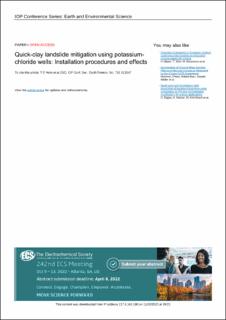| dc.contributor.author | Helle, Tonje Eide | |
| dc.contributor.author | Kvennås, Marianne | |
| dc.contributor.author | Kirkevollen, O. V. | |
| dc.contributor.author | Hamel, B. | |
| dc.contributor.author | Bache, Bjørn Kristian Fiskvik | |
| dc.contributor.author | Strand, S. A. | |
| dc.contributor.author | Svanø, G. | |
| dc.contributor.author | Gylland, A. | |
| dc.contributor.author | Haugen, E. | |
| dc.contributor.author | Wiig, T. | |
| dc.contributor.author | Horn, A. | |
| dc.date.accessioned | 2022-05-09T16:06:35Z | |
| dc.date.available | 2022-05-09T16:06:35Z | |
| dc.date.created | 2022-03-06T10:01:29Z | |
| dc.date.issued | 2021 | |
| dc.identifier.citation | IOP Conference Series: Earth and Environmental Science (EES). 2021, 710 (012047), . | |
| dc.identifier.issn | 1755-1307 | |
| dc.identifier.uri | https://hdl.handle.net/11250/2994879 | |
| dc.description.abstract | Mitigation actions related to quick-clay slopes often induce undesirable changes to the terrain that may have negative impact on developed areas and local biodiversity. Soil improvement may prevent this. Lime-cement piling causes temporarily reduced slope stability and substantial climate-gas emissions. Less climate-gas emissions are associated to the production of potassium chloride (KCl). KCl improves the post-failure properties of quick clay so it renders not quick and may serve as an alternative to current landslide-mitigation. The mechanisms in this chemical process is well documented, but there exist no installation procedures for KCl wells, nor knowledge on cost/benefit or climate-gas emissions. This paper presents two installation procedures of KCl wells, and studies showing that the climate-gas emissions are far less than installing lime-cement piles. Further development of cost-effective installation procedures is needed to justify application of KCl wells in quick-clay areas. | |
| dc.language.iso | eng | |
| dc.title | Quick-clay landslide mitigation using potassium-chloride wells: Installation procedures and effects | |
| dc.type | Peer reviewed | |
| dc.type | Journal article | |
| dc.description.version | publishedVersion | |
| dc.source.pagenumber | 10 | |
| dc.source.volume | 710 | |
| dc.source.journal | IOP Conference Series: Earth and Environmental Science (EES) | |
| dc.source.issue | 012047 | |
| dc.identifier.doi | 10.1088/1755-1315/710/1/012047 | |
| dc.identifier.cristin | 2007826 | |
| dc.relation.project | Norges forskningsråd: 284697 | |
| cristin.ispublished | true | |
| cristin.fulltext | original | |
| cristin.qualitycode | 1 | |
